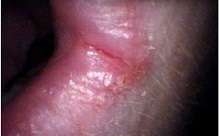Plummer–Vinson syndrome
| Plummer–Vinson syndrome | |
|---|---|
| Classification and external resources | |
| ICD-10 | D50.1 |
| ICD-9-CM | 280.8 |
| DiseasesDB | 10134 |
| MedlinePlus | 001158 |
| eMedicine | med/3431 |
| MeSH | D011004 |
Plummer–Vinson syndrome (PVS), also called Paterson–Brown–Kelly syndrome or sideropenic dysphagia, is a rare disease characterized by difficulty in swallowing, iron deficiency anemia, glossitis, cheilosis and esophageal webs.[1] Treatment with iron supplementation and mechanical widening of the esophagus generally provides an excellent outcome.
While exact data about the epidemiology is unknown, this syndrome has become extremely rare. The reduction in the prevalence of PVS has been hypothesized to be the result of improvements in nutritional status and availability in countries where the syndrome was previously described.[1] It generally occurs in postmenopausal women. Its identification and follow-up is considered relevant due to increased risk of squamous cell carcinomas of the esophagus and pharynx.[1]
Presentation

PVS sufferers often complain of a burning sensation with the tongue and oral mucosa, and atrophy of lingual papillae produces a smooth, shiny, red, dorsum of the tongue.Symptoms include:
- Dysphagia (difficulty in swallowing)
- Pain
- Weakness
- Odynophagia (painful swallowing)
- Atrophic glossitis
- Angular stomatitis
Serial contrasted gastrointestinal radiography or upper gastrointestinal endoscopy may reveal the web in the esophagus. Blood tests show a hypochromic microcytic anemia that is consistent with an iron-deficiency anemia. Biopsy of involved mucosa typically reveals epithelial atrophy (shrinking) and varying amounts of submucosal chronic inflammation. Epithelial atypia or dysplasia may be present.
Causes
The cause of PVS is unknown; however, genetic factors and nutritional deficiencies may play a role. It is more common in women,[2] particularly in middle age (peak age is over 50). In these patients, esophageal squamous cell carcinoma risk is increased;[1] therefore, it is considered a premalignant process.
The condition is associated with koilonychia, glossitis, inflammation of the lips (cheilitis), and splenomegaly. Esophageal web in Plummer-Vinson syndrome is found at upper end of esophagus(post cricoid region) and Shatzki ring may be found at the lower end of esophagus.[3]
1)Barium swallow test shows subepithelial fibrosis in postcricoid area (webs) 2) Esophagoscopy shows a hypopharyngeal web
Prevention
Good nutrition with adequate intake of iron may prevent this disorder.[2]
Treatment

Treatment is primarily aimed at correcting the iron-deficiency anemia. Patients with PVS should receive iron supplementation in their diet. This may improve dysphagia and pain.[1]If not, the web can be dilated during upper endoscopy to allow normal swallowing and passage of food.[4]
Prognosis
Patients generally respond well to treatment. Iron supplementation usually resolves the anemia, and corrects the glossodynia (tongue pain).[1]
Complications
There is risk of perforation of the esophagus with the use of dilators for treatment. Furthermore, it is one of the risk factors for developing squamous cell carcinoma of the oral cavity, esophagus, and hypopharynx.[5]
History
The disease is named after two Americans: the physician Henry Stanley Plummer and the surgeon Porter Paisley Vinson.[6][7][8]It is occasionally known as Kelly-Paterson syndrome in the UK, after Derek Brown-Kelly and Donald Ross Paterson.[6][9][10] However, Plummer–Vinson syndrome is still the preferred term.
See also
References
- 1 2 3 4 5 6 Novacek G (2006). "Plummer-Vinson syndrome". Orphanet J Rare Dis. 1: 36. doi:10.1186/1750-1172-1-36. PMC 1586011
 . PMID 16978405.
. PMID 16978405. - 1 2 "Plummer-Vinson syndrome: MedlinePlus Medical Encyclopedia". 2011.
- ↑ Sabiston 18th/e p1078
- ↑ Enomoto M, Kohmoto M, Arafa UA, et al. (2007). "Plummer-Vinson syndrome successfully treated by endoscopic dilatation". J. Gastroenterol. Hepatol. 22 (12): 2348–51. doi:10.1111/j.1440-1746.2006.03430.x. PMID 18031398.
- ↑ "Plummer-Vinson Syndrome". PubMed Health. Retrieved 31 January 2012.
- 1 2 synd/1777 at Who Named It?
- ↑ H. S. Plummer. Diffuse dilatation of the esophagus without anatomic stenosis (cardiospasm). A report of ninety-one cases. Journal of the American Medical Association, Chicago, 1912, 58: 2013-2015.
- ↑ P. P. Vinson. A case of cardiospasm with dilatation and angulation of the esophagus. Medical Clinics of North America, Philadelphia, PA., 1919, 3: 623-627.
- ↑ A. B. Kelly. Spasm at the entrance of the esophagus. The Journal of Laryngology, Rhinology, and Otology, London, 1919, 34: 285-289.
- ↑ D. R. Paterson. A clinical type of dysphagia. The Journal of Laryngology, Rhinology, and Otology, London, 1919, 24: 289-291.